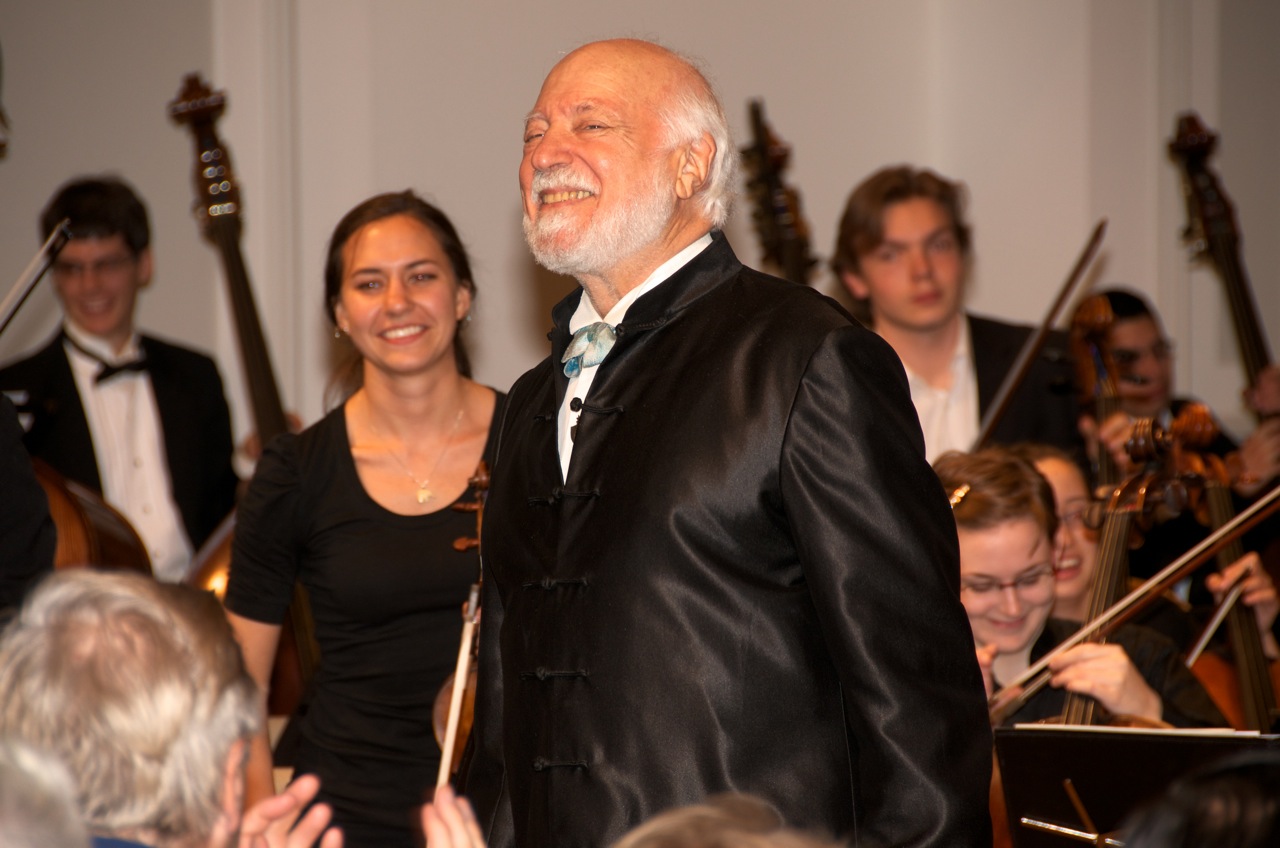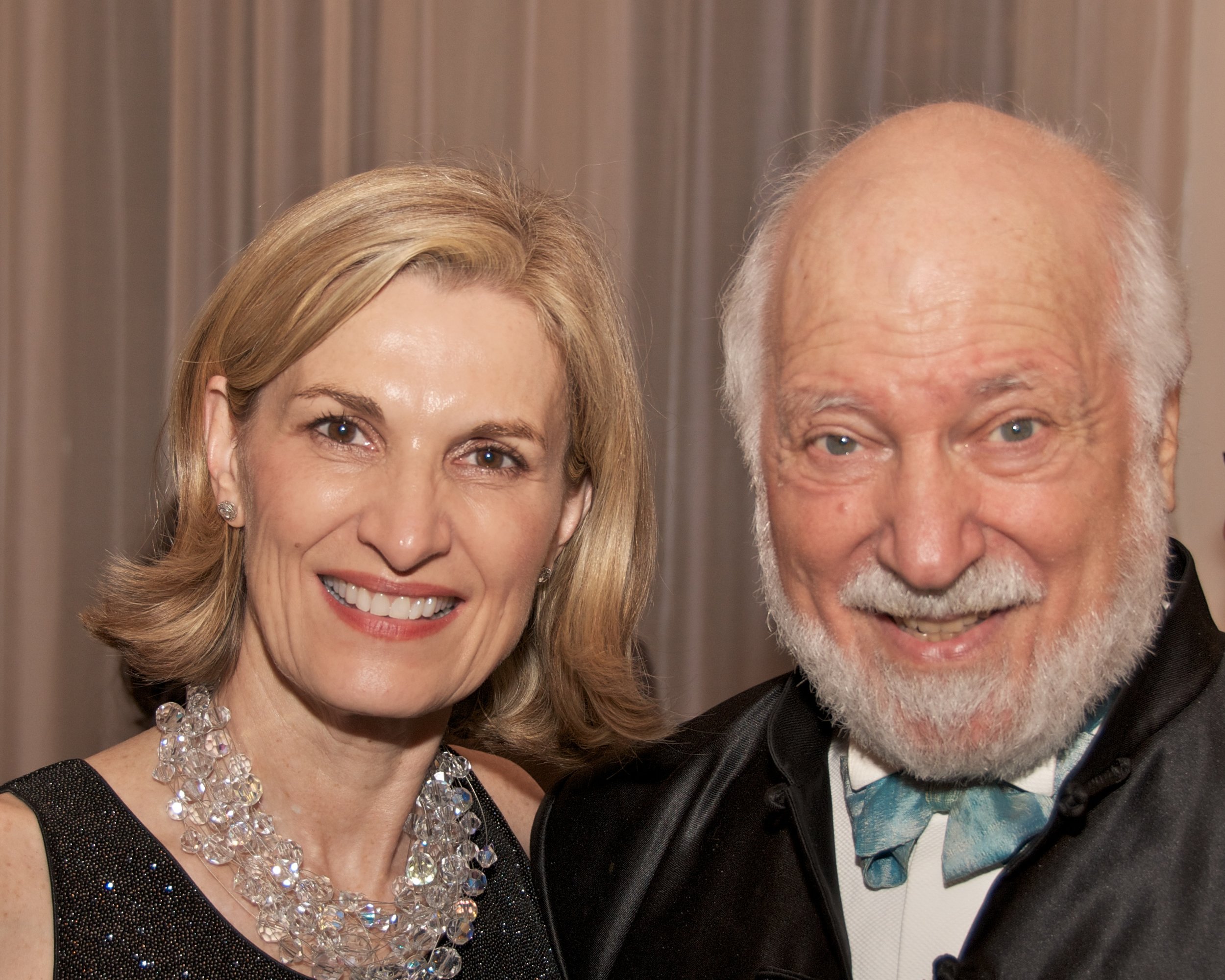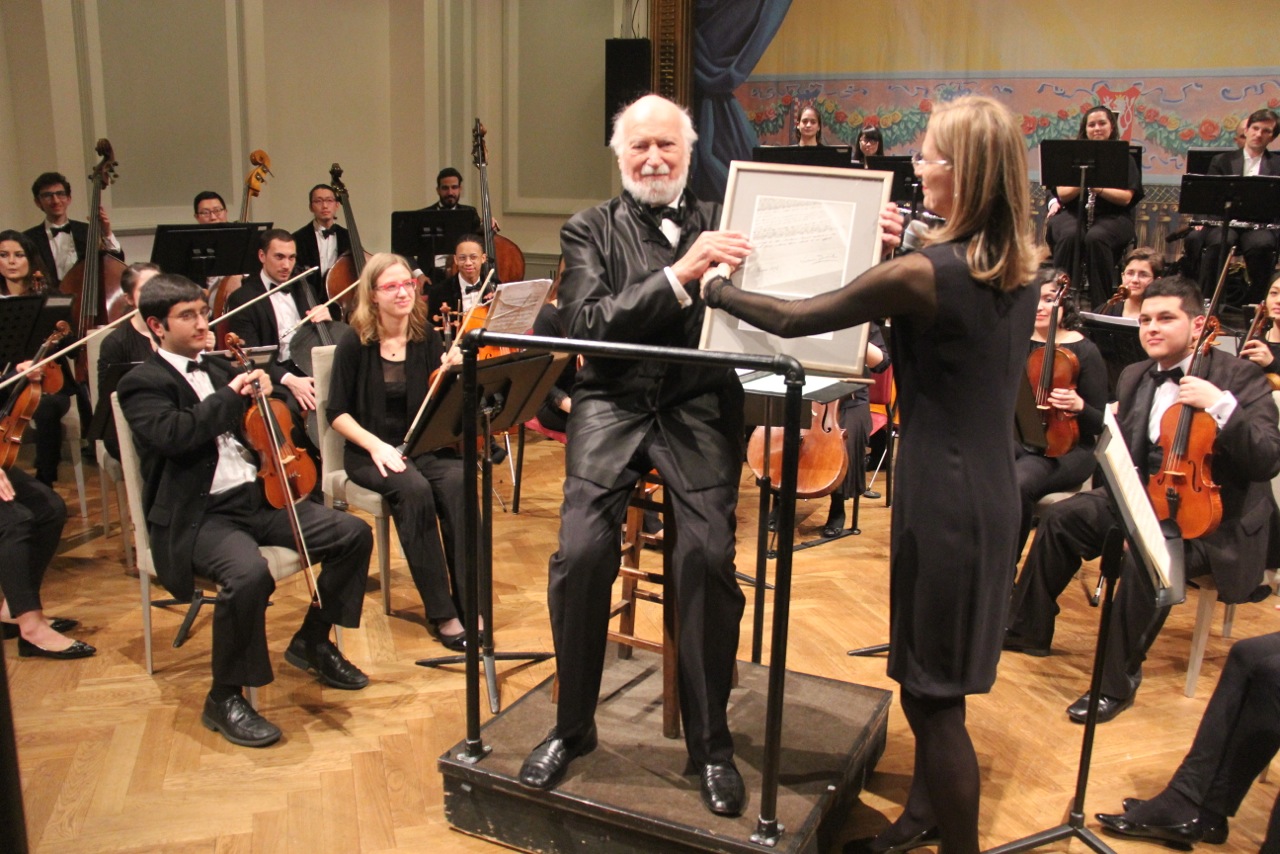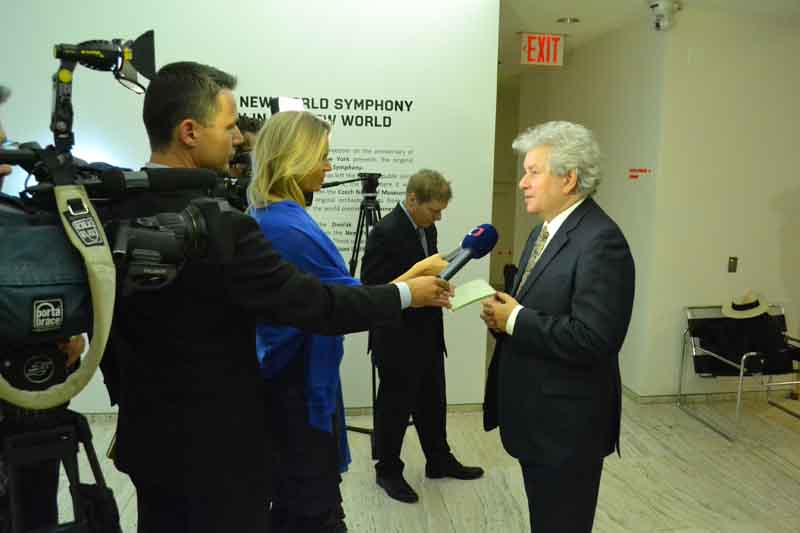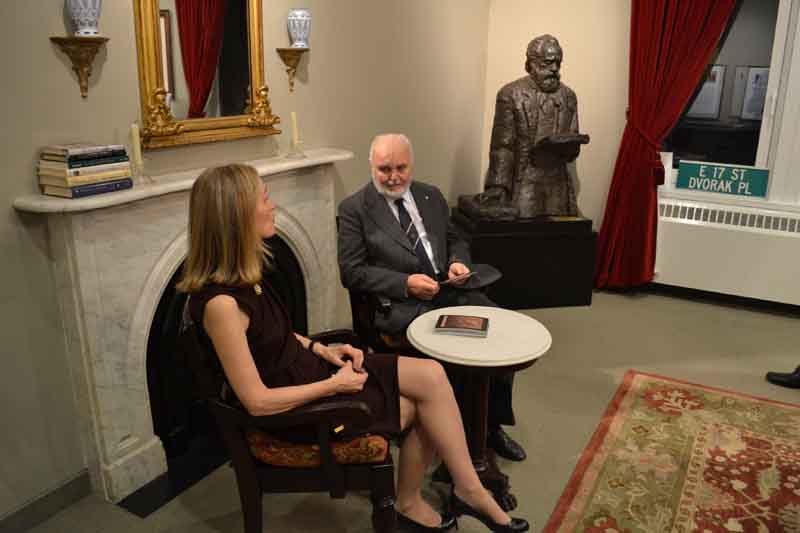DAHA IN THE NEWS:
STREAMING NOW!
DIMITRIJ BY ANTONÍN DVOŘÁK
DIMITRIJ BY ANTONÍN DVOŘÁK
A great nation in turmoil after the abrupt end to a ruling dynasty leaving no clear path forward. This was Russia in the Time of Troubles, the seventeenth-century period in which Antonín Dvořák set his 1882 opera Dimitrij.
Photo by Cory Weaver
DIMITRIJ OPERA TALK
with Dvořák scholar and DAHA Board Member Michael Beckerman
American Symphony Orchestra music director Leon Botstein is joined by Dvořák scholar Michael Beckerman for an insightful talk on Dimitrij and Dvořák as an opera composer.
“Dvořák for the Birds” by Professor Michael Beckerman of New York University
When considering the influence of America on Dvořák’s works, writers have tended to focus on whether and how the composer used musical material from the United States. But as this recent article by Professor Michael Beckerman suggests, Dvořák also viewed America as a natural space, and this and his love of birds ensured that birdsong was an integral part of his American vision.
Michael Beckerman is Carroll and Milton Petrie Professor of Music and Collegiate Professor at New York University. He is the author of six books including New Worlds of Dvořák, Martinů’s Mysterious Accident, and Janáček as Theorist, and has written widely on Czech topics, film music, Mozart, orientalism, music of the Roma, and most recently, composition in the camps and the question of the relationship between form and musical meaning. Beckerman has been a regular contributor to The New York Times, has appeared on many episodes of Live From Lincoln Center, and has lectured throughout North America, Europe, Asia and Australia. He has been the recipient of many prizes and honors, including two ASCAP Deems Taylor awards; an honorary doctorate from Palacký University in the Czech Republic; the Janáček and Dvořák medals and other awards from the Czech government; a Distinguished Alumni award from Hofstra University; and a Golden Dozen teaching award from NYU. He was recently made an honorary member of the Czech Musicological Society and will receive the Harrison Medal from the Irish Musicological Society. He has taught at Columbia University, Washington University, the University of Chicago, the University of California, Santa Barbara, Central European University, Charles University in Prague, and New York University where, from 2004-13 he served as department Chair. From 2011-15 he served as Distinguished Professor of History at Lancaster University in England and he was the Leonard Bernstein Scholar in Residence of The New York Philharmonic from 2016-18, as well as serving as Vice-President of the Dvořák American Heritage Association, actively contributing to its programs furthering knowledge and understanding of Dvořák’s legacy and Czech musical culture.
Click HERE to read article.
Milan Fryščak In Memoriam (1932-2020) by Michael Beckerman
DAHA and its Board note with extreme sadness the passing of Prof. Milan Fryščak. An important teacher, scholar, organizer and personality, his contributions to the world of Czech studies over more than forty years were exemplary. He received his BA at Palacky University in Olomouc, and after escaping from Czechoslovakia he became a refugee for two years until he arrived in the United States in 1959. He studied at the University of California Berkeley, receiving an MA degree, and taught at Wittenberg University in Ohio. He received his PhD in Slavic Linguistics at Ohio State University in 1969, and began his career at New York University in 1971. He is author of Say it in Czech and other writings, and has received many honors including the Charles University Memorial Medal on the occasion of the 650th anniversary of the founding of that institution. In his various leadership positions he played a significant role in Czech-American life, and was important in establishing New York University’s relationship to Prague and the Czech Republic broadly.
In addition to his honors and awards, and his contributions as a teacher and organizer, Prof. Fryščak was a wonderful person, whose deep humanity touched all those who came into contact with him. We were always delighted to see him at our events, and he will be deeply missed at the Bohemian National Hall.
Maurice Peress Archives at Columbia University
The personal archives of distinguished American orchestral conductor, educator, and author Maurice Peress (1930-2017), a Founding Board Member of DAHA, now reside at Columbia University’s Performing Arts Collection, Rare Book and Manuscript Division, Butler Library. An article celebrating the archive and Peress’s diverse interests and accomplishments ranging from classical to avant-garde and jazz musical genres was published in American Music Review in Spring 2019. We invite you to access our DAHA YouTube channel in the links below to revisit some of his memorable orchestral performances and lectures at Bohemian National Hall. We greatly miss his leadership and passion for all things Dvořák!
For more information about the individual concerts, please visit Past Events on this website.
YouTube Links:
Orchestral Masterworks: The Cello Concerto March 26, 2017
Dvořák and Black Music: 1893 to Present (Panelist) February 26, 2017
Dvořák’s Czech Day Concert at the Chicago World’s Fair, 1893 March 19, 2016
DAHA’s 25th Anniversary Celebration (Panelist) April 26, 2015
Dvořák Legacy Concert: Symphony No. 9 in E Minor February 27, 2015
Dvořák to Duke Ellington (Lecture) November 18, 2014
Last concert organized by Maurice Peress for DAHA and performed as a Memorial on his 88th birthday: American Composer Focus: Leonard Bernstein March 18, 2018
JACK TAYLOR (1925-2019)
Preservation Advocate Who Fought For Dvořák House
The Dvořák American Heritage Association mourns the loss of Founding Board Member Jack Taylor. In 1990 Jack launched the effort to save the Dvořák House on East 17th Street, the place where Antonín Dvořák lived during his American residency from 1892 to 1895 and composed the “New World” Symphony. He was committed to saving this important cultural landmark and rallied the public to the cause. Though the battle was ultimately lost, he went on to help establish the Dvořák American Heritage Association and lead such efforts as the placement of a statue of Dvořák in Stuyvesant Square Park. The Dvořák Room in the Bohemian National Hall and the musical and educational programs that our organization mounts owe much to his generosity and support. We will miss him greatly and join in mourning his loss along with the many other organizations that he touched in his long and fruitful life.
New York Times Obituary, February 16, 2019
The New York Preservation Archive Project, Oral Histories Link
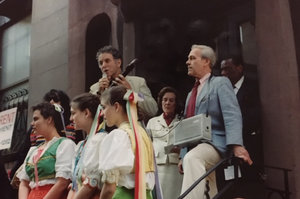

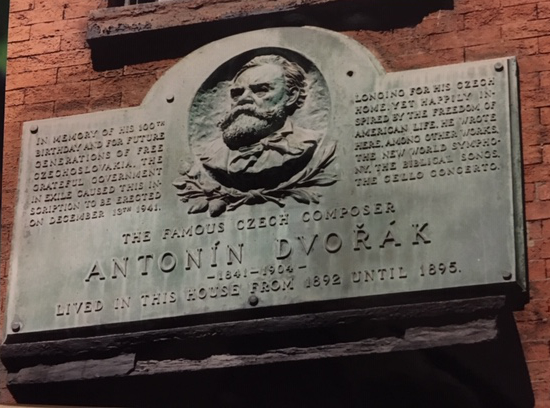


Overlooked No More: Sissieretta Jones, a Soprano Who Shattered Racial Barriers
Image Credit: Sissieretta Jones, Metropolitan Printing Co., 1899; Library of Congress, Prints and Photographs Online Catalog
The legendary black singer Sissieretta Jones (1868-1933) was featured in the New York Times series of obituaries of remarkable, but overlooked, women in American history on August 15, 2018.
Backstory: Czech Composer Antonín Dvořák and New York music impresario Jeannette Thurber played an important role in catapulting the singer to fame in a newsmaking 1894 Madison Square Garden concert. The event, organized by Thurber as a fundraiser for the New York Herald Clothing Fund, featured black soloists, students, and the orchestra of the National Conservatory of Music of America, the institution Thurber founded and oversaw as President. Dvořák, the Conservatory Director appointed by Thurber, conducted at the concert, and Jones was a soloist. The previous year Jones was the first black singer to headline a concert at prestigious Carnegie Hall.
Thurber broke barriers by offering full scholarships to students with musical talent - including African-Americans, women, and the physically disadvantaged - as part of her mission. She invited Dvořák to become Director of the Conservatory from 1892 to 1895 to help jump-start an American school of composition, and he in turn recognized "Negro spirituals" as the true folk music of America and a rich source of musical themes. He captured the deep feeling of such melodies in the famous Largo, the slow movement of his Symphony "From the New World," which was later set to words by William Arms Fisher, a student of his, as a spiritual titled "Goin' Home."
By Majda Kallab Whitaker
Photo Credit: New York Philharmonic Archives
Dvořák Manuscript Ranks Among Top Ten Treasures of New York Philharmonic Archives
New York Philharmonic Archivist and Historian Barbara Haws considers Dvořák’s “New World” Symphony manuscript to be among the top ten treasures she has unearthed in the New York Philharmonic Archives during her 34-year tenure. The document records how Dvořák’s renowned work, composed in New York City, was transformed by conductor Anton Seidl during rehearsals for the historic premiere on December 16, 1893. With the composer’s consent, Seidl changed the tempo of the famous second movement of the symphony from Larghetto to Largo, capturing the feeling of African-American spirituals that Dvořák heard sung by baritone Harry T. Burleigh of the National Conservatory of Music of America. Haws, who has lead digitization of the New York Philharmonic archives and provided unprecedented public access to its many holdings, is leaving to pursue her doctorate at Oxford University – delving into another treasure she unearthed: the travel diary of New York Philharmonic founder Ureli Corelli (1802-1875). Haws has collaborated with DAHA on many projects, as well as worked closely with DAHA Vice President, Professor Michael Beckerman, who has served as New York Philharmonic Leonard Bernstein Scholar-in-Residence from 2016 - 2018.
See the New York Times online article “10 Treasures, Unearthed From the New York Philharmonic’s Archives,” published in print Sunday, May 20, 2018 here.
New York Philharmonic Press Release: “Barbara Haws Named Archivist and Historian Emeritus at the New York Philharmonic,” April 18, 2018.
Barbara Haws lecture of 11/17/14 on DAHA’s YouTube Channel here.
By Majda Kallab Whitaker, DAHA
Maestro Maurice Peress, March 18, 1930 - December 31, 2017
Distinguished American orchestra conductor, educator, author.
The Dvořák American Heritage Association mourns the loss of Maurice Peress, fellow board member, esteemed colleague, friend, and passionate advocate of composer Antonín Dvořák. He was one of the founding members of DAHA and fought to save the house in which Antonín Dvořák lived during his American residency in the 1890s. He started our Concert and Lecture series in 2006. Author of "Dvořák to Duke Ellington: A Conductor Explores America's Music and its African American Roots" and other works, he was committed to Dvořák and to DAHA. He shared his enthusiasm for Antonín Dvořák with his students at the Aaron Copland School of Music who always excelled when they played at our events at the Bohemian National Hall, under the baton of Maestro Peress. It was an honor and privilege to have him among us and we will miss him greatly.
Susan Lucak, President, Dvořák American Heritage Association (DAHA)
Maurice Peress, Conductor Who Worked With Ellington, Dies at 87
From Antonín Dvořák to Rubin Goldmark and his Progeny
Rehearsal of Moshe’s Knoll’s “Psalm 133” for soprano, violin, and string orchestra. Photo credit: Laura Goldberg.
Who was Rubin Goldmark (1872-1936)? Answer: a star student of Czech composer Antonín Dvořák (1841-1904) at the National Conservatory of Music of America in the early 1890s, and nephew of the important late-19th century Hungarian-born Viennese composer Karl Goldmark. When the young Rubin Goldmark presented a work that pleased Dvořák, the great composer famously commented “Now there are two Goldmarks.” At the time Goldmark was already a teacher of piano and music theory at the National Conservatory in New York City. In a long career that included teaching at the Juilliard School of Music and private instruction, Goldmark was a leading light among musicians and famously taught other composers, among them Aaron Copland and George Gershwin, who are sometimes called “grand students” of Dvořák.
Moshe Knoll at piano. Photo: DAHA
Today we continue to learn of great- and great-great-grand students of Dvořák. Two have collaborated with the Dvořák American Heritage Association. Eric Ewazen, a Julliard faculty member whose works have been included in DAHA Spring Musicale programs, is a great-great-grand student of Dvořák, as the student of Milton Babitt, who studied with Philllip James, who studied with Rubin Goldmark. And composer, pianist, and DAHA Board Member Moshe Knoll recently discovered that one of his early teachers, Ozan Marsh, American pianist, pedagogue, arranger and composer at the University of Arizona, Tucson, studied directly under Goldmark, making Moshe the newest-minted great-grand student of Dvořák. Knoll recently premiered his Psalm 133 in concerts at the Merkin Concert Hall in New York and New Jersey Performing Arts Center in Newark. It’s a small world when it comes to Dvořák and American music composition!
By Majda Kallab Whitaker
DAHA Musical Notes
Star violinist Pavel Sporcl (with the blue violin) recently visited the Dvořák Room and Bohemian National Hall Ballroom to film a segment for his upcoming Czech TV series about famous Czech violinists. The focus: late-19th century violinistFrantišek Ondříček, who was encouraged to visit the United States by Antonín Dvořák and made his American debut with the New York Philharmonic in November 1895, playing Dvořák's Violin Concerto in A minor, Op. 53, which he had premiered in Prague in 1883.
Photo Credit: Majda Kallab Whitaker, DAHA
Harry T. Burleigh, African-American composer, arranger and professional singer. Photo courtesy of Jean E. Snyder.
Harry T. Burleigh (1866-1949): African-American Composer, Arranger, Baritone Singer, and Inspiration to Dvořák’s “New World” Symphony
DAHA recommends two new and noteworthy additions to Burleigh music appreciation and scholarship:
The recently formed Harry T. Burleigh Society has posted a recording of their path breaking concert: “Harry T. Burleigh Annual Service of Negro Spirituals at St. George’s Church: A Tribute,” performed on March 31, 2017. View the recording here http://bit.ly/2xq1rwn
Jean E. Snyder has published her milestone biography of Burleigh: Harry T. Burleigh: From the Spiritual to the Harlem Renaissance (University of Illinois Press, 2016). Purchase the book here: http://bit.ly/2y44qN6
DAHA Offers Pop-up Chamber Music Concert at Juilliard
On Friday, September 22nd, Juilliard students previewed Dvořák’s rarely heard String Quartet No. 2, performed later in full concert on Sunday, September 24th at 3 PM., as part of Dvořák’s Chamber Music Survey series presented at the Bohemian National Hall by the Dvořák American Heritage Association. Musicians from the New York Philharmonic and friends were featured; organized by violinist Laura Jean Goldberg, Juilliard faculty member and DAHA board member.
Eric Ewazen, Composer and Professor at The Juilliard School remarked:
"I am THRILLED that you brought your quartet to my class! What a glorious performance! It was a treat for me to hear this gorgeous and joyous piece!"
The students raved about this performance saying: "Cool experience!"
The Dvořák American Heritage Association Mourns the Loss of Two Beloved Figures from the Czech Music World:
Antonín Dvořák III, 88, grandson of Czech composer Antonín Dvořák
Jiří Bělohlávek, 71, Conductor of the Czech Philharmonic Orchestra
From the New York Times, June 1, 2017: “Jiri Belohlavek was the most devoted and to my mind the most profound proponent of Czech orchestral music in the world today,” Michael Beckerman, the Carroll and Milton Petrie Professor of Music at New York University and a Czech specialist, said by email. “His recordings and performances of Dvorak and Martinu, among other composers, were superb, thoughtful and filled with insight, but also wit and joy,” he added.
DAHA welcomed both in the Bohemian National Hall on several occasions and we will deeply miss them.
Insights at the Atrium Event Featuring Professor Michael Beckerman: “Origins of a New World Voice: NYC in 1893,” Monday, September 12, 2016
The New York Philharmonic 175th anniversary season commenced in late September with three exciting programs featuring Dvořák’s Symphony No. 9, From the New World — the Philharmonic’s first World Premiere of a work written in New York that would become part of the standard repertoire. That history-making premiere took place in December 1893, and provides this year’s theme for the Philharmonic’s programming and educational outreach.
Kicking off the New York Philharmonic’s anniversary activities and The New World Initiative—which coincide with the 175th anniversary of the birth of Antonín Dvořák—the New York Philharmonic presented a free Insights at the Atrium event, “Origins of a New World Voice: NYC in 1893,”Monday, September 12, 2016, at 7:30 PM. A theatrical exploration of Dvořák’s time in New York and the American influences in his New World Symphony, the event was led by Professor Michael Beckerman, the author of Dvořák and His World, who has been named The Leonard Bernstein Scholar-in-Residence at the New York Philharmonic for the 2016–17 season.
Dr. Beckerman was joined by actors reenacting the reception of African American musical sources at the dawn of the Progressive Era and how they contributed to the development of an American musical voice. The event, co-presented with Lincoln Center for the Performing Arts, took place at the David Rubenstein Atrium at Lincoln Center. As The Leonard Bernstein Scholar-in-Residence, Michael Beckerman will be involved with public outreach and education programs throughout the season and work with the Philharmonic Archives on projects related to Dvořák, contributing further to The New World Initiative.
The Leonard Bernstein Scholar-in-Residence at the New York Philharmonic program honors and recognizes the enduring contribution of Leonard Bernstein, the Orchestra’s Music Director from 1958 to 1969 and subsequent Laureate Conductor. The position was created in the 2005–06 season to coincide with the 15th anniversary of Bernstein’s death, on October 14, 1990.
For more information, click here!

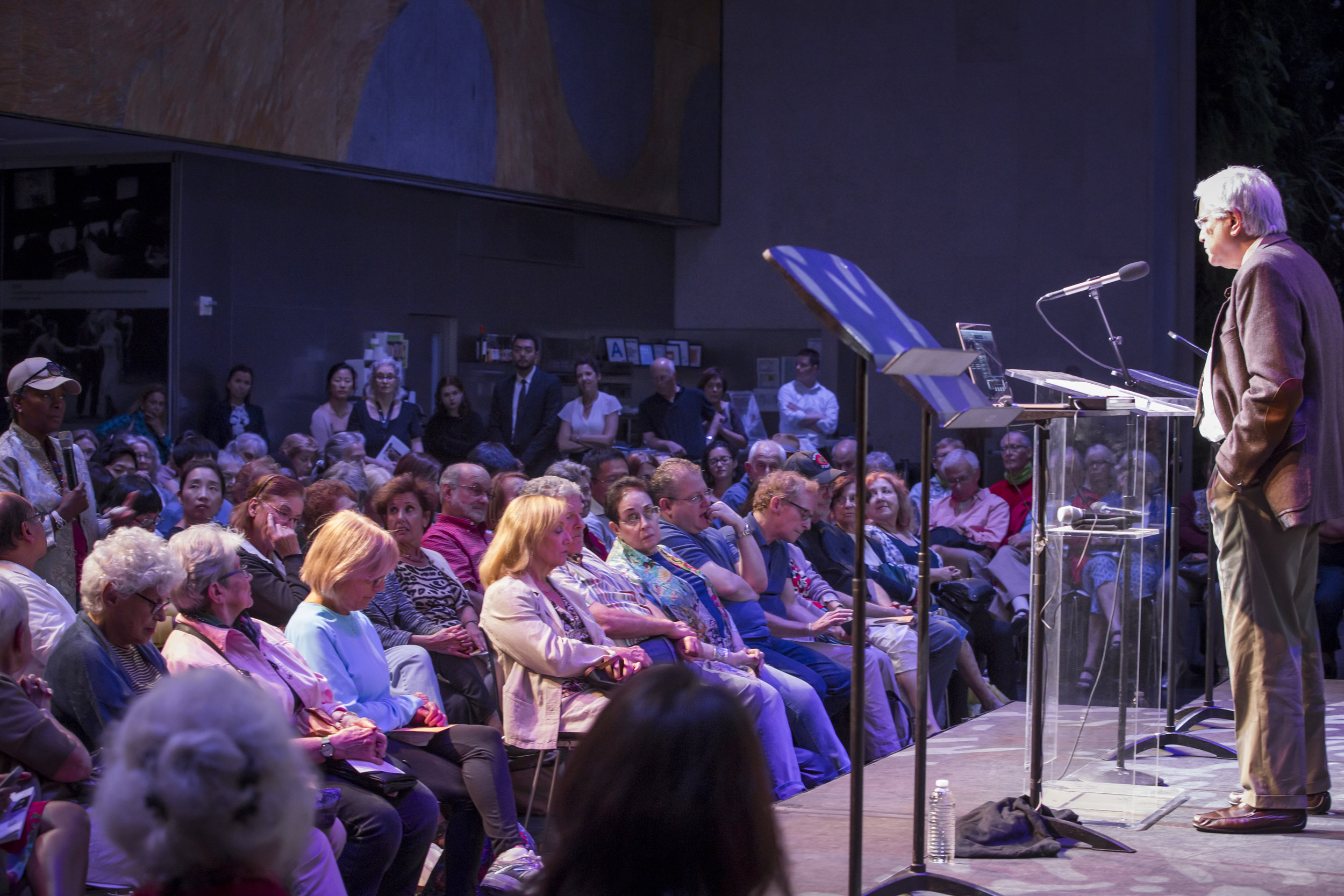
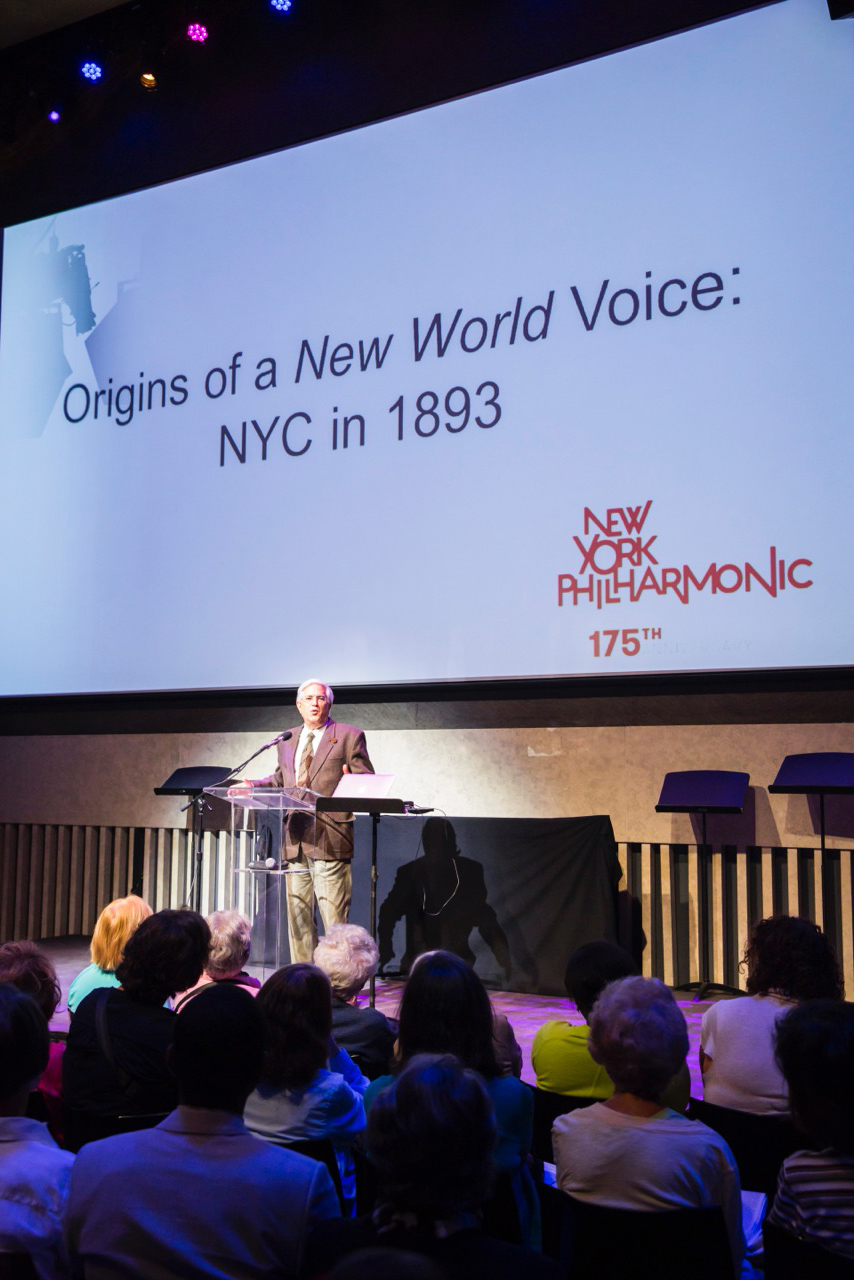
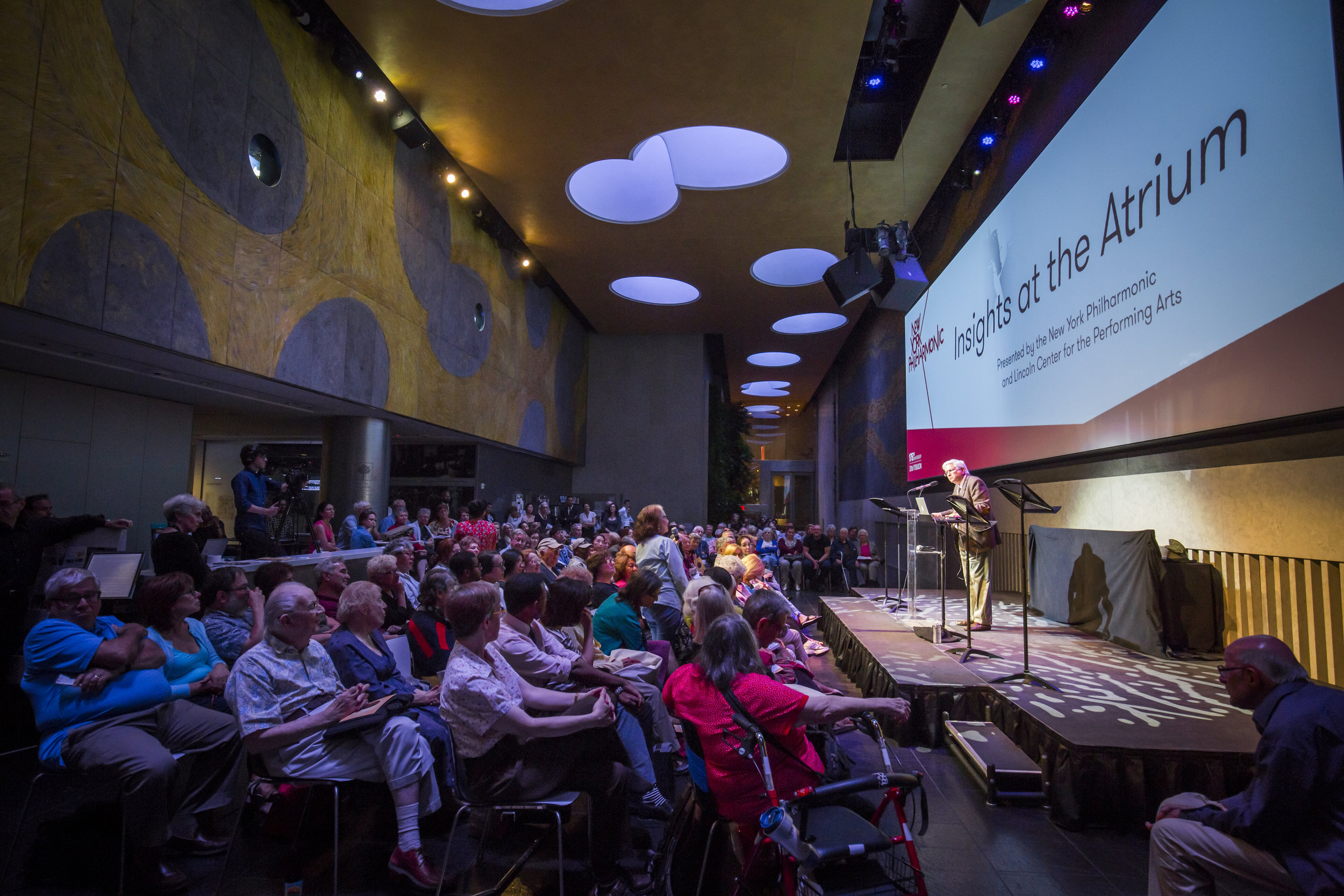
Professor Michael Beckerman, Leonard Bernstein Scholar-in-Residence at the New York Philharmonic, lectures and performs with actors at Lincoln Center Rubenstein Atrium. Photo Credit: New York Philharmonic
Michael Beckerman Lectures on Dvořák and Martinů
Musicologist and DAHA Vice President Michael Beckerman discusses the music of Dvořák and Martinů in conjunction with a performance by the Pavel Haas Quartet at the Library of Congress, which featured Martinů's String Quartet no. 3, H. 183, and Dvořák's String Quartet in D minor, op. 34 and String Quartet in F major, op. 96 ("American"). Published on June 16, 2016.
https://m.youtube.com/watch?v=yxTIcurTyBI
For transcript and more information, visit http://www.loc.gov/today/cyberlc/feature_wdesc.php?rec=7272
The House in Prague and the Dvořák Statue in New York
The House in Prague, a new book by Anna Nessy Perlberg, explores her childhood memories of her musically talented mother and her family’s life in Prague, shattered in 1938 by the Nazi invasion of Czechoslovakia. Featured in the recent Literary Festival: Prague Summer Program at the Bohemian National Hall in New York City, the book is linked to the Dvořák Room and its collection in an intimate way. Nearly ten years ago the Dvořák American Heritage Association received a generous gift of an etching of composer Antonín Dvořák by noted Czech artist and caricaturist Hugo Boettinger (1880-1934). The print bears the artist's dedication to Czech soprano Julia Nessy Bacherová – “excellent interpreter of Dvořák’s songs, April 5, 1932.” The gift to DAHA was made by Anna Nessy Perlberg, in memory of her mother, Mrs. Bacherová, who was one of the group of Czech emigrees who commissioned the bronze statue of Dvořák now in Stuyvesant Square Park, near the former site of Dvořák’s residence in New York, from 1892-95.
The House in Prague by Anna Nessy Perlberg (Emmaus, Pennsylvania: Golden Alley Press, 2016). http://goldenalleypress.com/anna-nessy-perlberg/
In this memoir that reads like a novel, we meet Anna’s shining and beautiful opera singer mother, her prominent lawyer father, and their circle of friends that includes Albert Schweitzer and the family of Czech President Thomas Masaryk.
Born in Prague’s Malá Strana, Julia Nessy Bacherová (1889-1981) dedicated her life to music, graduating from the Prague Conservatory and starting as the youngest violinist in the Czech Philharmonic Orchestra. She later performed as harpist in the same orchestra and eventually had a rich career as a concert and opera singer, with Dvořák songs prominent in her repertory. She held the Dvořák etching close to her throughout her life.
When the etching was received and placed next to the plaster cast of the Dvořák Statue in the Dvořák Room, it became evident that the print had served as the inspiration for the sculptor Ivan Meštrović (1883-1962) when creating the statue. Both statue and etching show Dvořák in the act of composing, standing by a piano, right hand on the keyboard, while he looks at a music score. Like long lost friends, the two artworks came together in the Dvořák Room once again, where they are permanently on view, along with a copy of The House in Prague.
By Majda Kallab Whitaker, DAHA
Golden Alley Press Editor Nancy Sayre and DAHA Board Member Majda Kallab Whitaker display book The House of Prague and etching of Dvořák next to statue by Ivan Mestrovic in Dvořák Room. Photo courtesy of Czech Center New York.
Michael Beckerman, Carroll and Milton Petrie Professor of Music at New York University and Vice-President of the Dvořák American Heritage Association, was featured in a New York Times article on December 4th, with comments about the New York Philharmonic’s original orchestral parts from the “New World” Symphony. He participated in the program “Insights Immersion: The Many Worlds of Antonín Dvořák” offered as part of the NY Philharmonic’s Dvořák Festival on Sunday, December 7th at the 92nd Street Y in New York City.
Image of Dvořák's New York Philharmonic Certificate, 1894. Photo by Eva Heyd, courtesy of Antonin Dvořák III & DAHA.
The accompanying exhibition, mounted by the Archives of the New York Philharmonic on the Grand Promenade of Avery Fisher Hall, presented two contributions from the Dvořák American Heritage Association: DAHA’s archival treasure, the original contract that brought Antonín Dvořák to America, signed “Antonín Dvořák. Prague 1892,” which is the only existing copy of the contract; and a photograph of the Honorary Membership Certificate awarded to Dr. Antonín Dvořák by the Philharmonic Society (New York Philharmonic) in April, 1894, documented by DAHA in the Czech Republic courtesy of Antonín Dvořák III. The exhibit was on view through the end of January 2015.
Check out the latest DAHA New York Times coverage, "Dvorak’s ‘New World’ Manuscript to Revisit New York" by Allan Kozinn, November 3, 2014: http://nyti.ms/1ySzM2w
Read the New York Times article about DAHA's recent exhibition, "The Deal that Brought Dvořák to New York" by Michael Cooper, Saturday; August 24, 2013: http://nyti.ms/1iEcU1h
See also "Unfinished Dvořák Manuscript To Be Presented in New York," April 3, 2014 in The Strad: http://bit.ly/1mZL2at






